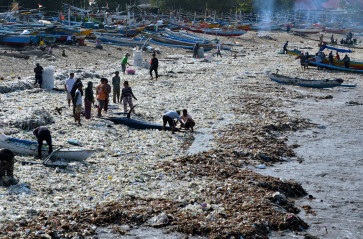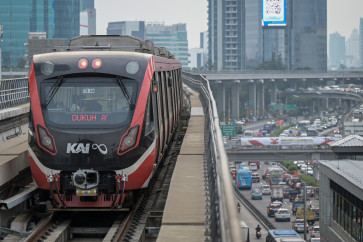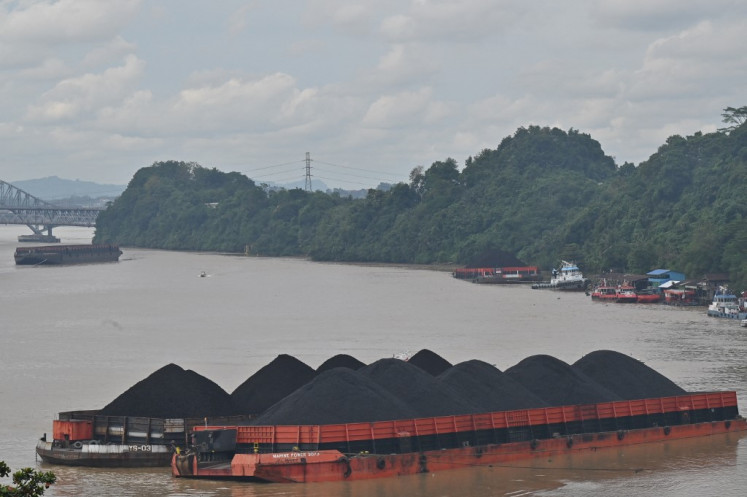Lapindo: Long-term taxpayer burden
These days Niscahul Munir can only reminisce about the bountiful days of the past, when the water was clear and he could return home with a full catch of fish
Change text size
Gift Premium Articles
to Anyone

T
hese days Niscahul Munir can only reminisce about the bountiful days of the past, when the water was clear and he could return home with a full catch of fish.
Now, the waters of the Madura Strait are thick with oily mud and on a good day he might come home with only 3 kilograms of fish. Most of time, his nets are damaged by the heavy, cloying mud.
Niscahul is but one of hundreds of such fishermen in Nambangan village, which is located by the Madura Strait, in East Java. The strait has become the dumping ground for the runoff from the Lapindo mudflow in Sidoarjo,
16 kilometers to the southeast.
Niscahul recalls the better days with sadness. “I have been fishing since I was 15, and since the mudflow erupted in Sidoarjo, things have changed so much here,” he said.
He said that one need not go far out to sea to witness the environmental degradation. Even near the shore, he said, the water was no longer blue. Instead, it had turned dark brown and was very oily. Dead shellfish washed up on the shore.
The 32-year-old said he could no longer stay too long at sea. “My nets are soon covered in thick mud. It smells and it is so hard to know if I have caught anything because of the mud. I have to return to the shore and clean my nets. By the time I finish, it will already be too late to go out again. So I have to wait until the next day,” he said.
According to Niscahul, his income has dropped significantly because of the mud problem. At the moment he makes only about Rp 20,000 (US$2.12) per day. Before the disaster, he said, he could earn Rp 200,000 or more.
With so meagre an income, he is now deep in debt. However, Niscahul told The Jakarta Post, in typical Javanese fashion, that he considered himself lucky. “I’m still single and I don’t have to support a wife and children. My married friends are in a worse situation. They have to support their families with the little money they have,” he said.
On May 28, 2006, an accident occurred at an oil and gas drilling site belonging to Lapindo Brantas Inc. and hot mud has been flowing from the well ever since, causing immense environmental damage. In the past six years, 34,700 residents have been forced to evacuate.
On Monday, a coalition of environmental and human rights groups urged Lapindo, a company controlled by Golkar Party chairman Aburizal Bakrie and the government to find a comprehensive solution to deal with the disaster.
The coalition blasted the government and Lapindo for their handling of the problem.
“It’s been too long and there has been no definite solution. In the meantime, the environmental and social destruction continues,” Abdul Halim of the People’s Coalition for Fisheries Justice (Kiara) said.
A study by Kiara, conducted in June 2010, showed that the level of nitrogen and phosphates in the Madura Strait had spiked. The nitrogen content was between 16 and 18 times higher than that of other Indonesian waters and the phosphate content was 24.4 percent higher.
The study also found that the number of fishermen had declined as a result of sea contamination. In 2006, there were 2,868. In 2010, the number dropped to only 1,839.
The groups also slammed the government for spending excessively from the state budget to pay for the mudflow mitigation efforts.
The government has spent Rp 6.7 trillion (US$780 million) of taxpayer money for compensation and reconstruction, and has budgeted Rp 500 billion for 2012 for the same purpose. Lapindo Brantas has paid only Rp 2.8 trillion of Rp 3.9 trillion in required compensation.
In total, the government is estimated to spend more than Rp 9 trillion by 2014 for the Lapindo disaster.
“This shows that the company is the one in control,” coordinator for the Indonesian Forum for Budget Transparency (Fitra) Ucok Sky Khadafi said.
Andi Darussalam Tabussala, vice chairman of PT Minarak Lapindo Jaya, a subsidiary of Lapindo Brantas Inc., rejected the groups’ claims.
He reaffirmed the company’s previous statement that a team of experts had conducted research and decided that the disaster was caused by nature. (tas)
Impacts of the Lapindo mudflow
• The monetary value of the damages wrought by the continuous high-pressure mudflow have been estimated at Rp 27.7 trillion (US$2.9 billion) by the National Development Planning Agency and Rp 33.27 trillion by Greenomics Indonesia.
• The government has paid Rp 6.7 trillion in compensation to date and has budgeted Rp 500 billion for 2012 for the same purpose. Lapindo Brantas has reportedly paid only Rp 2.8 trillion of Rp 3.9 trillion in required compensation.
• The mudflow led to an explosion that killed 14 at a gas pipeline owned by state oil firm PT Pertamina.
• More than 600 hectares have been submerged since the mudflow began, displacing 39,700 people and submerging 3 subdistricts, 12 villages, 11,241 buildings and 362 hectares of rice fields.









